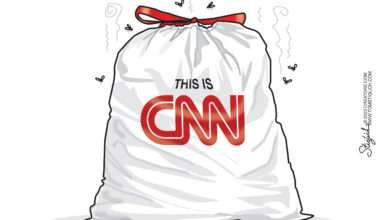A New Media Slant Detector
I formerly believed that reporters don’t tell the public what to think. Instead, they tell the public what to think about — as if that made claiming “objectivity” while misusing your influence an acceptable practice.
Experience disabused me of that erroneous notion. For as Martha Bayles observes, “What [the media] does is condition us, gradually and over time, to accept, or at least view as normal, attitudes and behaviors we might otherwise reject.”
Wash, rinse, repeat and soon the sparkling clean brain is ready to vote Democrat.
The ongoing debt crisis offers two examples of how liberal media preoccupations distort coverage. First, let’s eavesdrop on how a family cuts their budget. Mary is worried about credit card debt and wants John to reduce the $250 a month he spends on lunch at Hooters, so they can increase the monthly payment to Indentur–card. John recognizes the problem and agrees to a 20 percent cut. Next month he’ll spend $200, a $50 reduction.
Compare that to coverage of “cuts in spending” the debt ceiling deal will allegedly produce. When the Washington Post refers to cuts, it doesn’t mean a reduction compared to what was spent last year, it means a reduction in the amount of increased spending. Government isn’t spending a penny less, it just doesn’t get to increase spending as much as Leviathan would prefer.
If John applied this pretzel logic to his agreement with Mary he would say, “Gee Hon, the new Hooters waitress is smokin’ and I was fixing to spend $350 this month. But since you’re such a Debbie Downer, I’ll cut 50 percent and only spend $300.”
Obviously any news outlet that uses the word “cuts” instead of “reduced spending increase” in reference to the debt deal is slanting the facts.
Case two: the Congressional Debt Supercommittee. Rational people wonder if the committee can produce a package of cuts that will stop the nation’s slide into insolvency. Sunday the irrational Post runs a hysterical story complaining the committee “is marked by a problem that has plagued Congress — a lack of gender and racial diversity.”
This is the equivalent of demanding the Titanic offer a drum circle, in addition to the orchestra, to entertain passengers entering the lifeboats. So far voters, to their eternal credit, do not appear to be concerned with racial and reproductive bean–counting, but are worried about results.
When news consumers are presented with an endless litany of stories that posit illiterate minority youth can’t find a job because “society failed them,” the recession continues due to a “lack of government economic intervention” and homosexuals should be able marry because “love is love;” it’s no surprise many voters eventually support social programs, think politicians can actually manage the economy and wonder if a nice homosexual couple will buy the foreclosure next door.
So how do conservatives and independents combat media ideological contamination? They can start with “Left Turn: How Liberal Media Bias Distorts the American Mind,” by Tim Groseclose a professor of political science and economics at UCLA.
Groseclose uses a complicated mathematical model to analyze print and broadcast media to arrive at what he terms a “slant quotient” or SQ. A score of 100 for a news outlet indicates the product resembles Nancy Pelosi’s constituent newsletter and a score of 0 means that news organization generates fan mail for Ayn Rand.
Details on methodology are in the book or you can visit Groseclose’s website: timgroseclose.com.
The website also has the SQ rankings of major news outlets and the Political Quotient (PQ) of prominent elected officials. Even better, you can take a test to see how your PQ matches up with current and past office holders.
On his scale, Michele Bachmann (R–MN) comes in at a negative 4.1, which I assume means she voted against all liberal legislation and then assaulted a Democrat. Barney Frank (D–Debauched) scored 103.5; meaning he voted for all the liberal legislation and then, well, let’s not think about that.
My test score was 5.3 and means I’m less conservative than Sen. Jim DeMint (R–SC) at 5.1 and more conservative than Groseclose who scored 13.
The site can also helps one make prudent purchasing decisions. I subscribe to four newspapers, which is one too many. Either the Wall Street Journal or the Washington Times must go.
You can imagine my surprise when I learned the Journal has a SQ of 85.1, which is 18.5 points higher than the Post’s 66.6 and puts the WSJ smack dab between Joe Biden and Hillary Clinton! While the Times is a respectable 35.4.
Come November, when I let my WSJ subscription lapse, I’ll be saving hundreds of dollars and fighting media bias.




